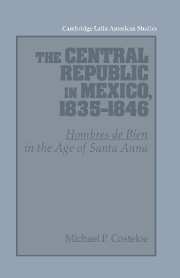Book contents
- Frontmatter
- Contents
- Preface
- Acknowledgements
- 1 An introduction: change and continuity in the Age of Santa Anna
- 2 The end of federalism
- 3 The transition to centralism: stage I
- 4 The transition to centralism: stage II
- 5 Las Siete Leyes
- 6 Anastasio Bustamante and the centralist republic, 1837–1839
- 7 Santa Anna versus Bustamante: the end of the Siete Leyes, 1839–1841
- 8 ‘La dictadura disfrazada con el hermoso nombre de regeneración política’
- 9 Santa Anna and the Bases Orgánicas
- 10 ‘La revolución de tres horas’
- 11 Herrera and the rise of Paredes y Arrillaga
- 12 Hombres de bien and the restoration of federalism
- 13 Conclusion
- Sources and works cited
- Index
- CAMBRIDGE LATIN AMERICAN STUDIES
11 - Herrera and the rise of Paredes y Arrillaga
Published online by Cambridge University Press: 23 October 2009
- Frontmatter
- Contents
- Preface
- Acknowledgements
- 1 An introduction: change and continuity in the Age of Santa Anna
- 2 The end of federalism
- 3 The transition to centralism: stage I
- 4 The transition to centralism: stage II
- 5 Las Siete Leyes
- 6 Anastasio Bustamante and the centralist republic, 1837–1839
- 7 Santa Anna versus Bustamante: the end of the Siete Leyes, 1839–1841
- 8 ‘La dictadura disfrazada con el hermoso nombre de regeneración política’
- 9 Santa Anna and the Bases Orgánicas
- 10 ‘La revolución de tres horas’
- 11 Herrera and the rise of Paredes y Arrillaga
- 12 Hombres de bien and the restoration of federalism
- 13 Conclusion
- Sources and works cited
- Index
- CAMBRIDGE LATIN AMERICAN STUDIES
Summary
We saw the patriot tumblers
The twenty-third of May;
They met in merry Mexico
To dance their country away.
The 6 December coup was an oddity in the gallery of Mexican pronunciamientos. Although almost certainly prearranged and not the spontaneous event sometimes depicted, it was not a party political affair and did not have ideological motives. It was not staged, for example, by federalists, centralists, monarchists or any other group intent on constitutional reform. Nor did its perpetrators represent any particular interest group such as merchants or clergy, and while Paredes definitely had personal ambitions, it was not a conventional coup involving army officers seeking advancement or political power. In contrast – and this feature is unusual, if not unique – it did reflect a rare consensus of opinion among the myriad political, social and economic groups. Without exception, they came to agree, coincidentally or by arrangement, on one common objective and that was to remove Santa Anna from power. In short, Santa Anna had alienated hombres de bien in general, and by his conduct had brought about an unprecedented alliance of all the rival forces on the political stage. For the time being, they were willing to forget their differences and unite in the movement against him.
This anti–Santa Anna alliance, however, was a strictly temporary phenomenon; once its objective was achieved, it disintegrated and the various rival factions rapidly began to work to fill the vacuum left by the dictator's departure.
- Type
- Chapter
- Information
- The Central Republic in Mexico, 1835–1846'Hombres de Bien' in the Age of Santa Anna, pp. 261 - 283Publisher: Cambridge University PressPrint publication year: 1993



